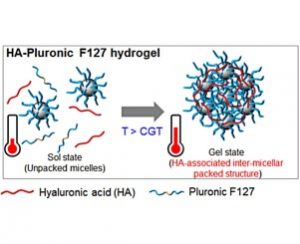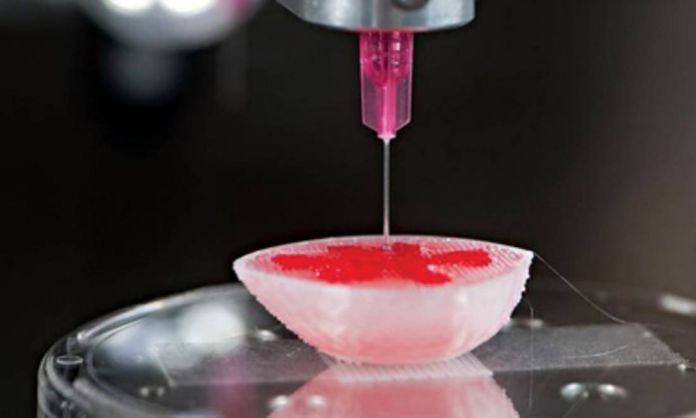Bioink refers to substances made of living cells that can be used for 3D printing of complex tissue models. Bioinks are materials that mimic an extracellular matrix environment to support the adhesion, proliferation, and differentiation of living cells. Bioinks distinguish themselves from traditional biomaterials such as hydrogels, polymer networks, and foam scaffolds due to their ability to be deposited as filaments during an additive manufacturing process. They can be alginate-based, gelatin based, pluronics, and decellularized ECM-based.
Alginate is a naturally derived biopolymer from the cell wall of brown algae that has been widely used as a biomaterial. Alginates are particularly suitable for bioprinting due to their mild cross-linking conditions via incorporation of divalent ions such as calcium. These materials have been adopted as bioinks through increasing their viscosity. Additionally, these alginate-based bioinks can be blended with other materials such as nanocellulose for application in tissues such as cartilage.
Gelatin has been widely utilized as a biomaterial for engineered tissues. The formation of gelatin scaffolds is dictated by the physical chain entanglements of the material which forms a gel at low temperatures. However, at physiological temperatures (body temperature), the viscosity of gelatin drops significantly. Methacrylation of gelatin is a common approach for the fabrication of gelatin scaffolds that can be printed and maintain shape fidelity at physiological temperature. Methacrylation is important for restorative material properties and bioengineering.
Decellularized Extracellular Matrix
Decellularized extracellular matrix based bioinks can be derived from almost any mammalian tissue. However, most organs such as heart, muscle, cartilage, bone, and fat are decellularized, lyophilized, and pulverized, to create a soluble matrix that can then be formed into gels. These bioinks have advantages over other materials due to their derivation from mature tissue. These materials consist of a complex mixture of decellularized extracellular matrix and proteins specific to their tissue origin. Therefore, dECM-derived bioinks are particularly tailored to provide tissue-specific cues to cells. Often these bioinks are cross-linked through thermal gelation or chemical cross-linking such as through the use of riboflavin.
Pluronics have been utilized in printing application due to their unique gelation properties. Below physiological temperatures, the pluronics exhibit low viscosity. However, at physiological temperatures, the pluronics form a gel. A more permanent pluronic-based network can be formed through the modification of the pluronic chain with acrylate groups that may be chemically cross-linked.
So, I have done my obligatory duty of informing you with new material. However, I am not here to only be a scribe with no life. Let us get a little more excited about this article. Is it not wild to think that most of the materials used in bioinks are readily synthesizable? I could order all of this and make some in my own home if I wanted. I also think the material properties discussed are so vast and interesting. Just having a little bit of organic chemistry as well as biochemistry knowledge leads a user to fully enjoy and soak in the importance of biomaterials. I believe it is necessary for me to at some point show some live demonstrations of synthesis with these materials. Talking gets boring after a while, but practical work gets exciting.
Subscribe to Our Email Newsletter
Stay up-to-date on all the latest news from the 3D printing industry and receive information and offers from third party vendors.
You May Also Like
3D Printing Unpeeled: Biofuel Waste to Filament & Sustainable Photopolymers
I can’t ever remember a day with so many potentially high impact news stories have come out. In one story, we all know that there are problems with the safety...
Finnair Hires AM Craft to 3D Print Plastic Parts for Aircraft Interiors
Riga-based AM Craft, a supplier specialized in 3D printing aviation components and certified under EASA Part 21G, announced a significant achievement today. The company will assist in upgrading Finnair’s A320...
3DPOD Episode 198: High Speed Sintering with Neil Hopkinson, VP of AM at Stratasys
Neil Hopkinson, a pioneering 3D printing researcher, played a pivotal role in developing a body of research that is widely utilized today. He also invented High Speed Sintering (HSS), also...
3D Printing Webinar and Event Roundup: May 12, 2024
Webinars and events are picking up in the AM industry this week! ASTM International continues its Professional Certificate Course and Stratasys continues its advanced in-person trainings, while 3D Systems is...


































